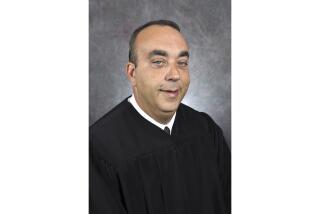Marchers Raise Voice in County
Thousands of marchers clogged Ventura County streets Monday with demands for immigration reform and social justice as local May Day activism mirrored the massive protests in major cities coast to coast.
Organizers called the event “A Day Without Immigrants” and mobilized hundreds of thousands of marchers across the country, including 3,000 who converged on Oxnard in the biggest protest in Ventura County. Speeches and marches also occurred at smaller gatherings in Fillmore, Ojai and Ventura.
While organizers had urged people not to show up for work, the results were mixed. Migrant workers were absent from the fields Monday because they had worked the weekend in exchange for growers giving them the day off to join demonstrations. Ventura County, the nation’s 10th-largest agricultural county, produces lemons and avocadoes as well as most of the nation’s strawberries, according to agriculture officials.
“I haven’t seen anyone working,” said Rob Roy, president of the Ventura County Agricultural Assn. “In terms of the local agriculture industry, 99%-plus of the workers are foreign-born.” At the El Pollo Loco restaurant in Oxnard, Luis Galvaz was one of three workers on the seven-member crew who showed up for work, prompting the restaurant to close the drive-through window. “I haven’t had a day off in 10 days,” he said. “I wanted to take today off, but I need the money. Doing May Day is not going to bring me money.”
Shopkeepers who defied calls to close reported slower-than-usual business. In Santa Paula, Gabriella “Gabie” Araiza Reeves, owner of La Cabana Mexican restaurant on Harvard Boulevard, said she was forced to close at 3 p.m. after receiving bomb threats and menacing phone calls. She said she stayed open because she disagreed that street protests were the way to address immigration reform. Police patrolled the street outside the restaurant, but no incidents were reported.
“We’re a little shook up. I’m one of the few restaurants open [Monday] in Santa Paula,” Araiza said. “I don’t think this is the best way to handle this situation. There are other ways of protesting besides making everyone close their shops.”
For the most part, however, the demonstrations went off without incident. In Oxnard, where 66% of the population is Latino, the mood was festive as marchers launched the afternoon rally with cries of “Vamanos!” (Let’s go!) Mothers pushed strollers; teens in jeans and white T-shirts carried signs; and men waved American flags. One sign read: “We won’t go back. We’ll fight back.”
Protesters moved steadily toward Plaza Park in the center of town, gathering more participants as they proceeded down 5th Street. A smaller rally earlier in the day drew about 700 at the Inlakech Cultural Center.
Antonio Caranza, 41, a nursery foreman who left Mexico and became a citizen five years ago, said: “I have many family members who do not have papers. That’s why I’m here. Next, I will vote.”
Two sisters and a brother who skipped school to attend held signs at one of the Oxnard rallies, demonstrating on behalf of family members, some of whom are illegal immigrants. Dailyn Garcia, 12, said: “People are here [in America] to support their children. Mexico is a beautiful country, but America has more jobs.”
Matt Holm, a 34-year-old Oxnard College student, said he was impressed by the Spanish-speaking throng. But, he added, “to get their point across to America, they need to speak English, because America doesn’t know what they’re saying.”
Simi Valley City Councilman Glen Becerra said not all county residents celebrated the marches. He said many of his constituents were “disgusted by the approach that’s being taken to change the country.”
“I don’t think this plays very well in Ventura County,” Becerra said. “There’s a lot of concern about the rule of law. What do you do for all the individuals who are waiting their turn, are in the process” of legal immigration?
Jose Marichal, a political science professor at California Lutheran University in Thousand Oaks, said the protesters have demonstrated solidarity, but he questioned whether their efforts in the street will translate into power at the ballot box or reforms in Congress.
“Symbolically, it’s good for those groups that feel excluded socially to assert their power, but I’m not sure what impact it will have on the larger policy context,” Marichal said. “If it stays at a level of protests, that may wake up elected officials, but it has to be a voter registration movement before it influences policy-making decisions. Elected officials are watching it curiously, like everyone else, to see what happens.”
*
Times staff writers Gregory W. Griggs and Catherine Saillant contributed to this report.
More to Read
Sign up for Essential California
The most important California stories and recommendations in your inbox every morning.
You may occasionally receive promotional content from the Los Angeles Times.










